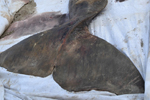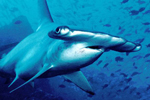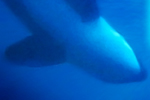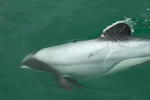It sounds ludicrous, but it could just be true: scientists say seagulls may be responsible for hundreds of southern right whale mortalities off the Argentine coastline. Since 2003, scientists have documented the deaths of 605 southern right whales (Eubalaena australis) near Península Valdés which the whales use as a nursery. Notably, 88 percent of these were newborn calves. The death rate is so high that researchers now fear for the whales’ long-term survival.
“The southern right-whale population is still only a small fraction of its original size, and now we have reason to worry about its recovery,” Vicky Rowntree with the Ocean Alliance and the University of Utah says. “Our long-term data indicate that the Península Valdés whales were increasing steadily at close to 7% per year until recently. Elevated calf mortality is reducing that growth rate substantially (by nearly a third in one estimate). If this continues, we just don’t know what will happen.”
Scientists now hypothesize that kelp gulls (Larus dominicanus) may be behind the high death rate, since the gulls repeatedly land on southern right whales pecking at them to tear off chunks of skin and blubber for food. The evidence for this hypothesis was recently discussed by researchers at the annual conference of the International Association for Aquatic Animal Medicine (IAAAM) in Sausalito, California.
 Kelp gull in Chile. Photo by: Jason Quinn/Creative Commons 3.0. |
“The attacks are very painful and cause large, deep lesions, particularly on the backs of young 2-6 week-old calves. The whales flinch violently and swim away to flee from the attacking gulls,” Rowntree and Mariano Sironi, Scientific Director of the Instituto de Conservación de Ballenas in Argentina, explain. “This harassment can last for hours at a time. As a result, right whale mothers and their calves are expending much precious energy during a time-of-year when mothers are fasting and at a site where little to no food is available to replenish fat reserves. The gull harassment and the extensive wounds they make must have a very negative effect on the health and body condition of these whales and is certainly very stressful.”
In fact, a recent study in the Journal of Cetacean Research and Management found that the kelp gulls usually target mother and calf pairs. Monitoring from 1995-2008 by Rowntree, Sironi and colleagues concluded that kelp gulls attacked mother and calves 88 percent of time. The researchers also believe that gull populations are on the rise due to “refuse available from fishing boats operating at sea and at fishery and urban landfills,” according to the paper. More kelp gulls and a rising southern right whale population seems to have increased the chances of bloody encounters.
“The proportion of whales with gull marks between 1974 and 2008 increased steadily from 1% of whales in 1974 to 37.8% in 1990, 67.6% in 2000, and 76.8% in 2008,” the scientists write adding that adult whales are changing their behavior to avoid the gulls. “Adult whales have learned to reduce the likelihood of being attacked by gulls by changing their resting posture at the surface, arching their backs to keep them underwater.”
Although the scientists aren’t yet ready to declare that kelp gull attacks are the smoking gun behind the high mortality rate, disease and toxins have largely been ruled out by autopsies on the whale’s bodies. Whatever is causing the mass deaths, scientists say time is running out as each year more whales are found dead.
“The current mortality of southern right whales at Península Valdés is unparalleled at a global scale. No other right whale population is losing so many calves each season,” notes Frances Gulland, with The Marine Mammal Center in Sausalito and host of the IAAAM Meeting.
The southern right whale is currently listed as Least Concern by the IUCN Red List after populations began to slowly rebound once hunting right whales—which includes three species—was banned in 1937. Right whales were so named because they were the “right” whales to target in the whaling industry.

Southern right whale near Península Valdés. Photo by: Michaël Catanzariti.
.600.jpg)
Southern right whale mother and calf. Photo by: G. Harris/Wildlife Conservation Society
CITATION: Mariano Sironi, Victoria J. Rowntree, Charles T. Snowdon, Luciano Valenzuela, and Carina Marón. Kelp gulls (Larus dominicanus) feeding on southern rightwhales (Eubalaena australis) at Península Valdés, Argentina: updated estimates and conservation implications. Journal of Cetacean Research and Management. SC/61/BRG19.
Related articles
Munching on marine plastic kills sperm whale

(05/07/2013) What do children’s toys, balloons, mattresses and plastic bags have in common? They can, along with more non-biodegradable pollutants, be found in the belly of a sperm whale, the topic of a new study in the Marine Pollution Bulletin. The same whale that swallowed Jonah from the Bible, Geppetto from Collodi’s Pinocchio, and the crew of the Pequod from Melville’s Moby-Dick is now swallowing trash from the Spanish-Mediterranean coast, and in the Strait of Gibraltar.
The world’s largest ‘waste dump’ is found in the Pacific Ocean
(05/06/2013) If you were to travel from the United States of America to Japan, you would most likely encounter what could be described as the world’s largest waste dump: a 100,000 tonne expanse of debris floating around a large region of the Pacific Ocean. The total area of this phenomenon has been said to equal the size of continental U.S., but the truth about its true size remains unknown.
Japan killed record low number of whales
(04/05/2013) Japan blamed environmental activists for a “record low” take during this year’s whaling season in the Southern Ocean, reports Kyodo News.
Has shark fin consumption peaked at 100M dead sharks per year?

(03/05/2013) While a new study warns that up to 100M sharks are killed annually, there are signs out of China that demand for shark fin may be on the decline. A study published last week in the journal Marine Policy estimated shark deaths at 100 million in 2000 and 97 million in 2010, suggesting a slight drop in shark killing. Meanwhile reports out of China in recent months suggest an accelerating decline in shark fin consumption. China is the top market for shark fin, which is consumed as a status symbol, typically at wedding ceremonies and business dinners.
Photo: Pod of 100,000 dolphins spotted off California coast
(02/21/2013) A ‘super mega-pod’ of some 100,000 dolphins was spotted off the coast of San Diego last week, according to a report from NBC San Diego.
Save Lolita: new film urges release of captive killer whale

(01/22/2013) Through his new 90-second PSA, Save Lolita, filmmaker Daniel Azarian wanted to connect people to the plight of Lolita on a deeply human level; the only problem: Lolita is an orca, also known as a killer whale. But the stark, moving PSA succeeds, given the sociability of an individual—human or orca—who was stolen from her family and held in captivity for the past 42 years at Miami’s Seaquarium.
Whale only known from bones washes up on beach in New Zealand

(11/05/2012) In 2010, a whale mother and male calf were found dead on Opape Beach in New Zealand. Although clearly in the beaked whale family—the most mysterious marine mammal family—scientists thought the pair were relatively well-known Gray’s beaked whales (Mesoplodon grayi). That is until DNA findings told a shocking story: the mother and calf were actually spade-toothed beaked whales (Mesoplodon traversii), a species no one had ever seen before as anything more than a pile of bones.
Maui’s dolphins still in danger of extinction despite New Zealand’s protective measures

(08/07/2012) The New Zealand government’s recent efforts to protect the world’s smallest dolphin have come under scrutiny from various conservation organizations at the 64th meeting of the International Whaling Commission (IWC). There are only 55 Maui dolphins (Cephalorhynchus hectori maui) now found on the west coast of New Zealand’s North Island, less than half the 2005 population with numbers continuing to decline. Less than 20 of the remaining Maui’s are breeding females and their slow reproductive rates make it difficult to increase their numbers when faced with an even bigger danger: fishing nets.
Humpback whales delaying migration due to Antarctic changes
(07/30/2012) Humpback whales in the Antarctic are delaying their migration to feed on krill that are staying later due to reduced extent of sea ice, a possible consequence of climate change, reports a study published in the journal Endangered Species Research.
Deepwater Horizon oil spill may have played role in dolphin deaths
(07/22/2012) In the first four months of 2011, 186 bottlenose dolphins (Tursiops truncatus) were found dead in the Gulf of Mexico, nearly half of them dolphin calves many of whom were perinatal, or near birth. Researchers now believe a number of factors may have killed the animals. Writing in the open-access journal PLoS ONE, scientists theorize that the dolphins died a sudden influx of freshwater from snowmelt after being stressed and weakened by an abnormally cold winter and the impacts of the BP oil spill.
Over 30 Yangtze porpoises found dead in China as population nears extinction

(05/01/2012) Six years after the Yangtze river dolphin (Lipotes vexillifer), or baiji, was declared “functionally extinct” by scientists, another marine mammal appears on the edge of extinction in China’s hugely degraded Yangtze River. In less than two months, 32 Yangtze finless porpoises (Neophocaena asiaeorientalis asiaeorientalis), a subspecies of the finless porpoise, have been dead found in Dongting and Poyang Lakes in the Yangtze, reports the World Wide Fund for Nature (WWF).
Video: All white killer whale spotted in Russia
(04/27/2012) Scientists in Russia have captured the first-known video footage of an all-white killer whale.